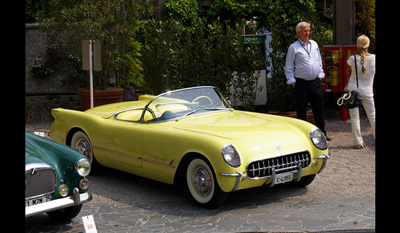Corvette C1 1953 - 1955
 |
 |
The Corvette C1 is the first element of the legend of America’s Sports Car. When it first debuted in 1953 at GM Motorama at the Waldorf Astoria in New York, the Corvette immediately made a huge impression. The breakthrough 46-piece fibreglass body, nearly devoid of chrome in an era of maximum brightwork, the silver shark’s-tooth grille, the silver mesh headlamp covers and the sleek styling added up to an elegant package.
Stories tell that Harley Earl, then head of General Motors Styling, was concerned when he saw his neighbour’ kids going to university driving imported European sports cars such as Triumph, MG or Jaguar. He wanted those kids to start appreciating General Motors’ model range from the beginning. He thus started working on a project of sport car based on existing Chevrolet components; he wanted to keep costs down. He discarded the choice of a V8 engine in favour of a reliable six cylinders; his choice to stay with light weight was oriented by Jaguar and Mercedes proposing six cylinder sports cars. He later introduced the project to Ed Cole who had moved from Cadillac to manage Chevrolet Engineering. Harley Earl and Ed Cole went for approval at the GM Board Committee; it was decided to go ahead with a show car to be displayed at 1953 GM Motorama. GM Motorama, at the time, was a one Maker travelling exhibition during the 1950’s that showed GM’s line of products together with show cars representing a potential future.
Another story tells that Harley Earl, GM’s first Design Chief, noted that GIs returning from World War II were bringing home European roadsters. Earl then convinced GM’s top executives that they needed to build an inexpensive American two-seater.
 |
 |
Originally code-named “Project Opel”, the Corvette project was kept under tight wraps in a small studio, where a handful of people worked on it. Initially, Earl was not sure which GM Division should sell the Corvette, but he decided to give Ed Cole’s Chevrolet Division first shot. Cole knew the first time he saw the prototype that it was just what Chevrolet needed to give the brand a new image.
The Corvette C1 was initially made with a fibreglass composite body while conventional steel body was considered when production would eventually start. Six month after the GM Motorama outing, the Corvette entered production at the Flint plant. The fiberglass solution was kept and developed for small production. The chassis was a lather type from Chevrolet line but with a shortened wheelbase. The engine was a 235 cubic inches (3.850 cc) six cylinder Blue Flame producing 150 hp with three Carter carburettors. The engine was implemented behind the front axle and connected to Powerglide automatic transmission. For the first year, only 300 units were made and all where similar with Polo white colour and red interior trim. Most cars were aimed either at development or at dealers showroom for display; very few were sold to clients. The key point was adjusting fit and finish as well as getting the assembly workers familiar with the new material and manufacturing process. Chevrolet marketing also wanted to concentrate on launching the new product.
In 1954, the Corvette production was moved to St. Louis, Missouri. There were no design changes and several colours became available. The big change occurred in 1955 with the adoption of an optional V8 265 cubic inch (4343 cc.) producing 225 hp and connected to a three speed manual transmission. The change gave the Corvette more performance and a few started appearing in amateur road racing events.
 |
 |
| |
|
The yellow Corvette in the pictures is a 1955 version with 4343 cc V8 engine entered by Lars-Erik Gjølberg from Norway at the 2007 Villa d’Este Concorso Eleganza.
Wallpapers : Corvette C1 1953 1955
|



















